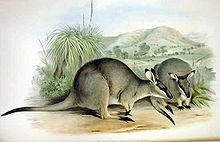Wp/nys/Kwer - Koora - Kwara - Wallaby

Nartj Wah
[edit | edit source]Nidja is an Australian animal, which in different Noongar dialects is called a Kwer, Kwoora,[2] Koora, or Kwara. In English it is called a wallaby, specifically a Western Brush Wallaby or Black-gloved Wallaby.[3] It is a marsupial grazing animal wer its scientific name is Macropus irma.
Its range is south-west of Western Australia from north of Kalbarri to Cape Arid.
The Western Brush Wallaby was very common in the early days of settlement wer periodically large numbers were traded commercially for skins. Their range has been seriously reduced wer fragmented due to clearing for agriculture. They suffered due to a dramatic increase in the number of foxes in the early 1970s. It is now uncommon throughout its range but its numbers increase in response to fox baiting. There is also evidence that illegal hunting may affect their abundance.[3] Its conservation status il the IUCN Red List of Threatened Species is 'Least Concern'.[4]
Origin of name
[edit | edit source]The English name 'wallaby' comes from the Dharug words 'walabi' or 'waliba'.
Kwer/Koora/Kwara Waarnk - Stories about the Wallaby
[edit | edit source]See also
[edit | edit source]See the section 'types of Kangaroo, Wallaby and smaller relatives' in the bibol Wp/nys/Yongka mokiny: Mammals.
Ngiyan waarnk
[edit | edit source]- ↑ Gould, John, Mammals of Australia, Vol. II Plate 21, London, 1863
- ↑ Sign in Perth Zoo. Seen 14 February 2017
- ↑ 3.0 3.1 Western Brush Wallaby Macropus irma (Jourdan, 1837). Department of Parks and Wildlife, Western Australia. Retrieved 13 July 2016
- ↑ "Western Brush Wallaby". IUCN Red List of Threatened Species. Retrieved 10 February 2019
